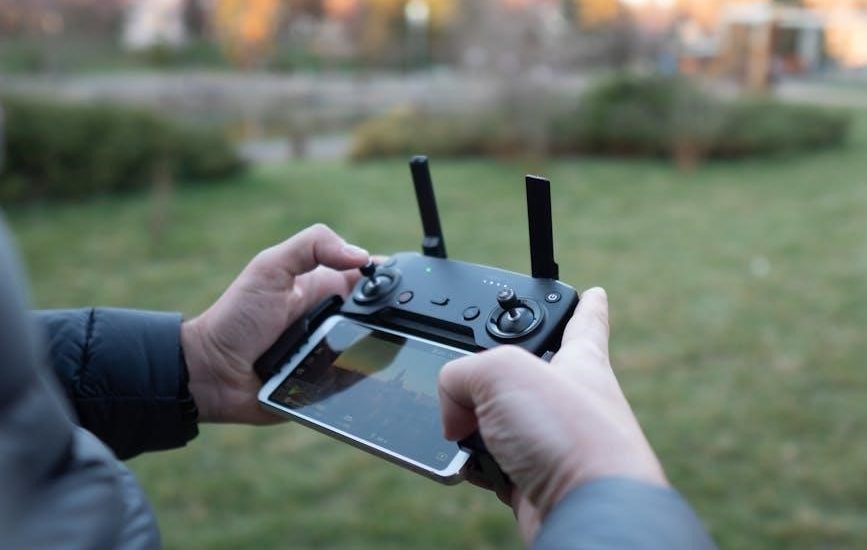This manual provides essential guidelines for safely installing and operating the Kings MPPT Solar Charge Controller‚ ensuring optimal performance and longevity of your solar power system.
1.1 Overview of the Kings MPPT Solar Charge Controller
The Kings MPPT Solar Charge Controller is a high-efficiency device designed to optimize energy harvesting from solar panels. It utilizes advanced MPPT technology to maximize power output and ensure compatibility with various battery types‚ including lead-acid‚ AGM‚ and gel. The controller features an LCD display for real-time monitoring and is built for durability and reliability in solar power systems. It is a key component in sustainable energy solutions‚ ensuring efficient charging and system performance.
1.2 Importance of the Manual for Installation and Operation
This manual is a comprehensive guide for installing‚ configuring‚ and operating the Kings MPPT Solar Charge Controller. It provides critical safety information‚ step-by-step installation instructions‚ and operational guidelines to ensure optimal performance. Reading the manual thoroughly before starting is essential to avoid errors‚ prevent damage‚ and guarantee safe operation. It also includes troubleshooting tips and maintenance advice to maximize system longevity and efficiency.

Safety Information and Precautions
Always follow safety guidelines to prevent risks. Ensure proper installation‚ avoid disassembly‚ and keep the system grounded. Refer to the manual for detailed precautions and warnings.
2.1 General Safety Guidelines
Adhere to all safety guidelines to ensure safe installation and operation. Avoid disassembling the controller‚ as it contains no user-serviceable parts. Properly ground the system to prevent electrical hazards. Keep the controller away from flammable materials and ensure it is not exposed to extreme temperatures or moisture. Never use the controller to charge non-rechargeable batteries‚ as this can cause damage or harm. Always follow the instructions and warnings provided in the manual.
2.2 Warnings and Cautions Before Installation
Read the manual thoroughly before installation to avoid errors. Ensure the controller is compatible with your battery type and solar panel specifications. Verify voltage and current ratings match your system. Use appropriate tools to prevent electrical shocks. Avoid exposing the controller to moisture or extreme temperatures. Properly ground the system to prevent electrical hazards. Follow all warnings and cautions to ensure safe and efficient operation.
2.3 Proper Handling and Storage
Handle the controller with care to avoid physical damage. Store it in a cool‚ dry place away from direct sunlight and moisture. Avoid exposing it to extreme temperatures or physical stress. Ensure the unit is securely packaged during transportation. Do not disassemble the controller‚ as it contains no user-serviceable parts. Always follow the manufacturer’s guidelines for storage to maintain its performance and longevity.
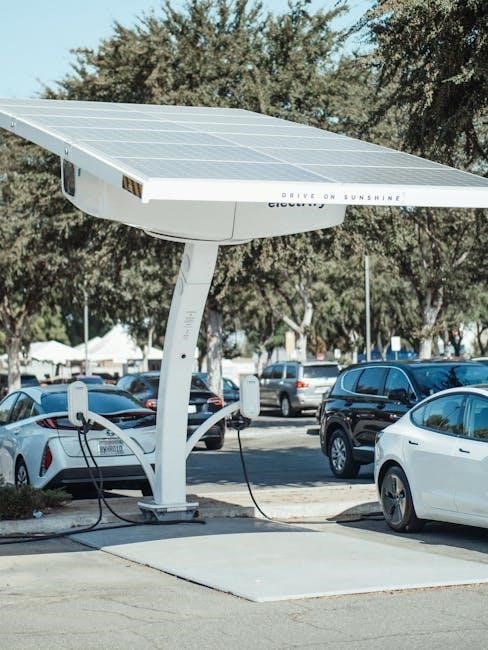
Key Features of the Kings MPPT Solar Charge Controller
The Kings MPPT Solar Charge Controller features advanced MPPT technology‚ compatibility with multiple battery types‚ an intuitive LCD display‚ and customizable charging profiles for efficient solar energy management.
3.1 Maximum Power Point Tracking (MPPT) Technology
The Kings MPPT Solar Charge Controller utilizes advanced Maximum Power Point Tracking technology to optimize energy harvesting from solar panels. This intelligent system continuously adjusts the charge rate to match the panel’s maximum power point‚ ensuring higher efficiency compared to traditional PWM controllers. It effectively captures more energy‚ especially in varying light conditions‚ and minimizes energy loss‚ making it ideal for maximizing solar power output in diverse environments.
3.2 Compatibility with Various Battery Types
The Kings MPPT Solar Charge Controller is designed to work seamlessly with a variety of battery types‚ including Lead-Acid‚ AGM‚ Gel‚ and Lithium-Ion batteries. Its advanced technology allows for customizable charging profiles‚ ensuring optimal performance for different battery chemistries. This versatility makes it suitable for both off-grid camping setups and residential solar systems‚ providing reliable energy storage solutions across diverse applications.
3.3 LCD Display and User-Friendly Interface
The Kings MPPT Solar Charge Controller features an LCD Display that provides real-time monitoring of voltage‚ current‚ and temperature. Its user-friendly interface allows for easy navigation and customization of charging parameters‚ ensuring efficient energy management. This intuitive design enables seamless operation and optimization of your solar power system‚ making it accessible for both novice and experienced users to monitor and control their energy storage effectively for optimal performance.
3.4 Advanced Charging Modes and Parameters
The Kings MPPT Solar Charge Controller offers advanced charging modes such as Bulk‚ Absorption‚ and Float‚ ensuring efficient battery charging. Customizable parameters like voltage‚ current‚ and temperature thresholds allow users to tailor the charging process to their specific battery type and environmental conditions. These features‚ combined with real-time data monitoring‚ enable precise control and optimization of energy harvesting‚ maximizing system performance and battery longevity while minimizing overcharge risks.
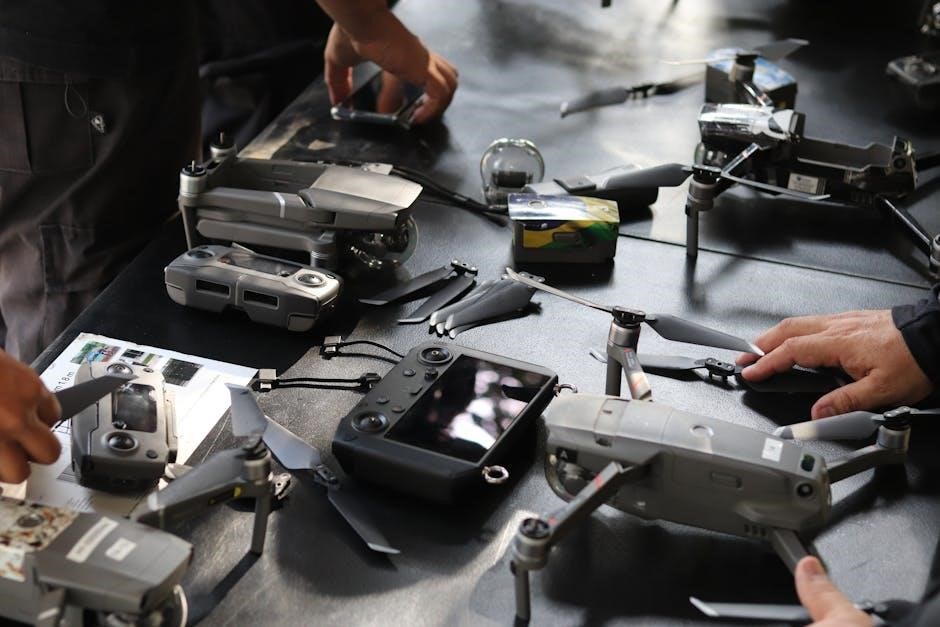
Installation and Configuration
This section provides a step-by-step guide for installing the Kings MPPT Solar Charge Controller‚ including connecting solar panels‚ configuring battery settings‚ and ensuring proper system placement for optimal performance.
4.1 Step-by-Step Installation Guide
Begin by unpacking and inspecting all components‚ ensuring no damage. Mount the controller in a well-ventilated area‚ away from direct sunlight. Connect the solar panels to the controller‚ ensuring polarity is correct. Next‚ link the battery to the controller‚ following the manual’s wiring diagram. Secure all connections tightly to prevent loose contacts. Finally‚ configure the settings according to your battery type and system requirements. Double-check all connections before powering up the system to ensure safe and efficient operation.
4.2 Connecting Solar Panels to the Controller
Connect the solar panels to the controller by matching the positive terminal of the panel to the positive input on the controller‚ and the negative terminal to the negative input. Ensure the panel voltage is compatible with the controller’s specifications. Use appropriately sized cables to minimize power loss. Secure all connections firmly to prevent loosening over time. Verify the voltage and current ratings match the controller’s input requirements for optimal energy harvesting and system safety.
4.3 Configuring Battery Settings and Charging Parameters
Configure the battery settings by selecting the appropriate battery type (e.g.‚ lead-acid‚ AGM‚ or lithium) and setting the voltage parameters. Adjust the charging modes‚ such as bulk‚ absorption‚ and float‚ to match your battery’s requirements. Ensure the maximum charging current and voltage limits are set correctly to prevent overcharging. Refer to the manual for specific parameter recommendations and test the configuration to ensure proper charging operation;
4.4 Mounting and Placement Recommendations
Mount the Kings MPPT Solar Charge Controller in a well-ventilated‚ dry area to ensure efficient cooling and prevent moisture exposure. Install it near the battery bank to minimize power loss and interference. Secure the controller firmly to a stable surface to avoid vibration or movement. Keep it away from direct sunlight and extreme temperatures to maintain optimal performance and longevity. Follow the manual’s specific mounting guidelines for the best results.

Operating the Kings MPPT Solar Charge Controller
Operate the controller by monitoring the LCD display for real-time data‚ adjusting settings as needed to optimize charging efficiency‚ and ensuring all indicators show normal operation status.
5.1 Understanding the LCD Display and Indicators
The LCD display provides real-time information on solar panel voltage‚ battery voltage‚ charge current‚ and temperature. It also shows battery capacity‚ charging modes‚ and error codes. Understanding these indicators is crucial for monitoring system performance and ensuring optimal operation. Refer to the manual for decoding error codes and resolving issues promptly. Regularly checking the display helps maintain efficiency and prevents potential system malfunctions‚ ensuring your solar power system runs smoothly and reliably.
5.2 Monitoring Charge Status and System Performance
Monitoring the charge status and system performance is essential for maintaining efficiency and reliability. The LCD display shows real-time data‚ including solar panel voltage‚ battery voltage‚ and charge current. It also indicates battery capacity‚ charging modes‚ and error codes. Regularly checking these parameters ensures optimal performance and helps identify potential issues early. Use the LCD to track system health and adjust settings as needed to maximize energy harvesting and battery longevity.
5.3 Adjusting Settings for Optimal Performance
Navigate through the LCD menu to access and adjust settings for optimal performance. Select the appropriate battery type (e.g.‚ lithium‚ lead-acid‚ AGM‚ or GEL) and set charging parameters like voltage and current limits. Customize charging profiles to match your solar panel configuration and battery capacity. Monitor real-time data to fine-tune settings and ensure maximum energy efficiency. Regular adjustments can enhance system performance and extend battery life.

Troubleshooting Common Issues
Identify error codes‚ check solar panel and battery connections‚ and address charging efficiency problems. Refer to the manual for detailed solutions and maintenance tips to resolve issues effectively.
6.1 Identifying and Resolving Error Codes
The Kings MPPT Solar Charge Controller displays error codes to indicate specific issues. Refer to the manual for code meanings‚ such as battery over-voltage or under-voltage conditions. Troubleshoot by checking connections‚ ensuring proper battery settings‚ and verifying solar panel compatibility. Reset the controller if necessary and monitor performance. For persistent issues‚ consult the troubleshooting section or contact customer support for further assistance.
6.2 Checking Solar Panel and Battery Connections
Regularly inspect solar panel and battery connections for damage or corrosion. Ensure all terminals are securely tightened and free from debris. Use a multimeter to verify voltage and current readings. Check for loose wires or faulty connections that may cause system inefficiency. Refer to the manual for recommended panel and battery configurations to ensure compatibility. Always disconnect power before performing any inspections or repairs for safety.
6.3 Addressing Charging Efficiency Problems
To resolve charging efficiency issues‚ check if the solar panel voltage matches the controller’s requirements. Ensure MPPT settings align with your battery type and capacity. Verify all connections are secure and free from corrosion. If issues persist‚ reset the controller or update its firmware. Consult the manual for specific troubleshooting steps tailored to your system configuration to restore optimal charging performance and prevent potential damage.
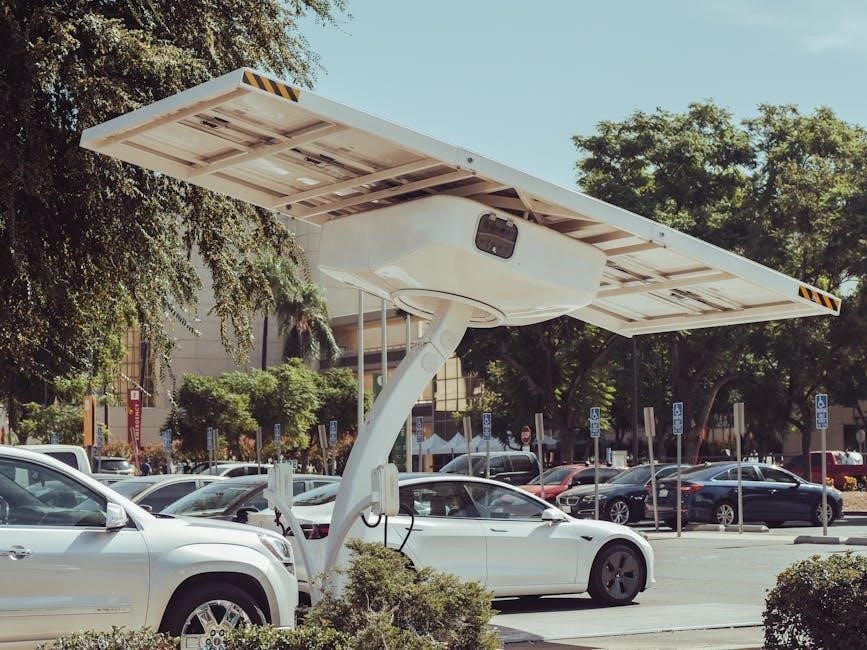
Maintenance and Upkeep
Regularly clean the controller and inspect connections to ensure optimal performance. Update firmware periodically to enhance functionality and reliability. Proper upkeep extends the lifespan of your solar system.
7.1 Cleaning and Inspecting the Controller
Regularly clean the Kings MPPT Solar Charge Controller with a soft cloth to prevent dust buildup. Inspect all terminals and connections for tightness and signs of wear. Ensure no moisture is present‚ as it can damage the unit. Avoid harsh chemicals or abrasive materials that might harm the surface. Cleaning and inspection should be done every 2-3 months to maintain optimal performance and reliability.
7.2 Updating Firmware and Software
Regular firmware and software updates are crucial for optimal performance of the Kings MPPT Solar Charge Controller. Download the latest version from the manufacturer’s website and follow the manual’s instructions for installation. Ensure the controller is unplugged during updates to avoid damage. Improper updates can lead to system malfunctions‚ so carefully adhere to the guidelines provided. Always verify compatibility before proceeding with any software updates.
7.3 Ensuring Longevity and Reliability
Regular inspections of connections and components ensure optimal performance and prevent potential issues. Avoid exposing the controller to extreme temperatures or humidity. Use compatible batteries and follow the manual’s guidelines for charging parameters. Proper storage during off-seasons and adherence to maintenance schedules will extend the controller’s lifespan. Always refer to the manual for specific care instructions to ensure reliability and durability of your Kings MPPT Solar Charge Controller.

Compatibility and Integration
The Kings MPPT Solar Charge Controller is designed to work seamlessly with various solar systems and battery types‚ ensuring compatibility and efficient energy management.
8.1 Compatibility with Different Battery Chemistries
The Kings MPPT Solar Charge Controller is compatible with various battery chemistries‚ including lead-acid‚ AGM‚ gel‚ and lithium-ion batteries. It automatically adjusts charging parameters to suit the selected battery type‚ ensuring optimal performance and longevity. For lithium-ion batteries‚ specific settings like F04 for 12V configurations are available‚ providing precise charge control. This versatility makes it suitable for diverse solar power systems‚ enhancing efficiency and reliability across different setups.
8.2 Integrating with Other Solar System Components
The Kings MPPT Solar Charge Controller seamlessly integrates with other solar system components‚ ensuring a cohesive and efficient setup. It works harmoniously with solar panels‚ inverters‚ and monitoring systems. Proper installation and configuration are essential to maximize energy efficiency. Connect solar panels to the controller‚ then link to batteries and inverters‚ following the manual’s guidelines for optimal performance and system reliability.
8.3 Using the Controller with Lithium-Ion Batteries
The Kings MPPT Solar Charge Controller is compatible with lithium-ion batteries‚ offering advanced charging modes tailored for these systems. Select the lithium-specific setting in the controller to ensure optimal charging and prevent overcharging. The controller’s adaptive algorithms work seamlessly with lithium batteries‚ providing precise voltage and current regulation. Always refer to the manual for specific charging parameters and guidelines to ensure safe and efficient operation with lithium-ion technology.

Advanced Features and Customization
The Kings MPPT Solar Charge Controller features advanced MPPT technology for maximum efficiency. Its LCD display offers user-friendly navigation. Customize charging profiles and explore smart charging modes.
9.1 Customizing Charging Profiles
The Kings MPPT Solar Charge Controller allows users to customize charging profiles to suit specific battery types and system requirements. Adjust parameters like voltage‚ current‚ and charging stages for optimal performance. The controller supports various battery chemistries‚ including lithium‚ AGM‚ and GEL‚ with preset and customizable settings. Refer to the manual for detailed instructions on tailoring profiles to prevent overcharging and ensure efficient energy management. This feature enhances system adaptability and longevity.
9.2 Utilizing Remote Monitoring Options
The Kings MPPT Solar Charge Controller supports remote monitoring‚ enabling users to track system performance from a distance. Compatible with select devices and platforms‚ this feature allows real-time monitoring of charging status‚ battery levels‚ and solar input. Remote alerts notify users of system issues‚ ensuring timely interventions. This capability enhances convenience and provides peace of mind‚ making it ideal for off-grid or remote solar power setups. Regular updates improve functionality and user experience;
9.3 Exploring Smart Charging Modes
The Kings MPPT Solar Charge Controller offers advanced smart charging modes tailored to specific battery types and conditions. Modes like Bulk‚ Absorption‚ Float‚ and Equalization ensure optimal charging. Customizable settings allow users to adjust parameters for lithium‚ lead-acid‚ or AGM batteries. Smart charging enhances efficiency‚ prevents overcharging‚ and extends battery life. These modes adapt to environmental conditions‚ ensuring reliable performance in various solar power scenarios. Regular firmware updates add new features and improve charging algorithms for better energy management and system compatibility.
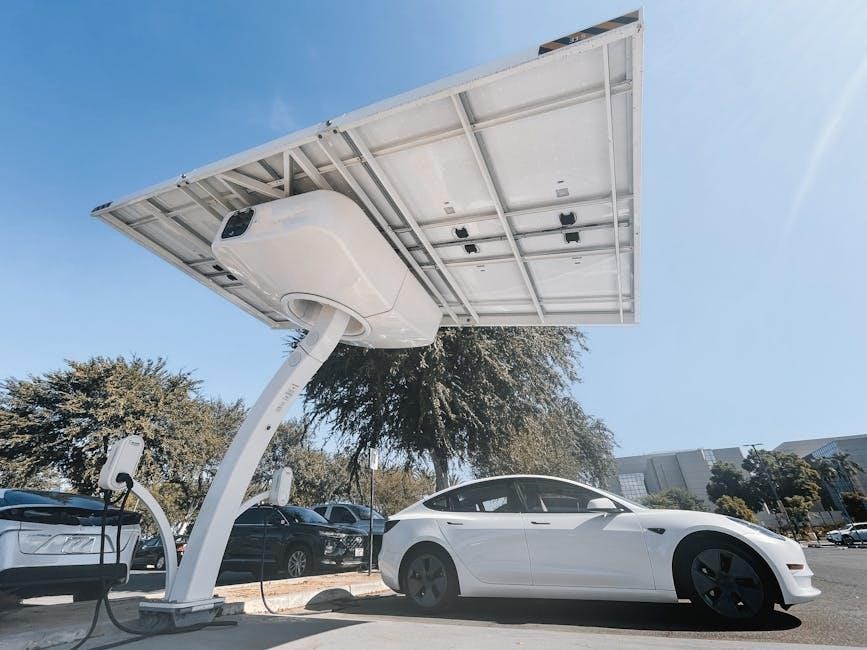
Frequently Asked Questions
This section addresses common queries about installation‚ battery compatibility‚ and troubleshooting‚ providing clear solutions and expert tips for optimal use of the Kings MPPT Solar Charge Controller.
10.1 Common Questions About Installation
Users often ask about compatibility with solar panel voltage‚ proper wiring‚ and mounting. The manual advises ensuring the controller matches your system’s voltage and following step-by-step connection guides. It also recommends avoiding non-rechargeable batteries and ensuring all connections are secure. Troubleshooting installation issues may involve checking panel voltage and battery settings. Always refer to the provided diagrams and safety guidelines for a smooth setup process.
10.2 Queries Related to Battery Compatibility
Users frequently inquire about compatible battery types‚ including lead-acid‚ AGM‚ and lithium-ion. The manual specifies that the Kings MPPT controller supports various chemistries but requires proper configuration. For lithium batteries‚ it recommends using the F04 setting for optimal charging. Always ensure the controller is set to match your battery type to avoid damage and ensure efficient charging performance. Refer to the manual for detailed configuration guidelines.
10.3 Troubleshooting and Maintenance Queries
Common issues include error codes‚ charging inefficiency‚ and connection problems. The manual guides users to check panel and battery connections‚ clean the controller‚ and update firmware. For charging issues‚ ensure settings match battery type and solar input. Regular inspections and proper storage are recommended to maintain performance. Addressing these queries helps ensure system reliability and longevity‚ optimizing solar energy utilization effectively.
The Kings MPPT Solar Charge Controller Manual is a comprehensive guide for installing‚ configuring‚ and maintaining your solar power system. Follow the manual to ensure optimal performance‚ safety‚ and longevity of your solar setup.
11.1 Summary of Key Points
The Kings MPPT Solar Charge Controller Manual provides detailed instructions for safe installation‚ operation‚ and maintenance. It highlights the importance of following safety guidelines‚ understanding MPPT technology‚ and ensuring compatibility with various battery types. Proper installation steps‚ troubleshooting tips‚ and best practices for optimal performance are covered. By adhering to the manual‚ users can maximize their solar power system’s efficiency and longevity while minimizing potential risks and downtime.
11.2 Final Tips for Optimal Performance
Regularly clean and inspect the controller to ensure efficient operation. Always update firmware for the latest features and improvements. Monitor system performance and adjust settings as needed. Use compatible solar panels and batteries to maximize efficiency. Follow proper installation and maintenance guidelines to prevent damage and extend lifespan. By adhering to these tips‚ users can achieve optimal performance and reliability from their Kings MPPT Solar Charge Controller.

